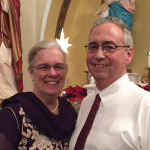Credited with establishing Catholic Schools in the United States of America, we owe much to St. Elizabeth Ann Seton. As a young wife and mother of five, she didn’t set out to head up a religious order. She wasn’t looking to launch a system of education. Rather, like Andrew in today’s Gospel, she simply pointed others to Jesus Christ.
The child of an Episcopalian physician, as a young woman, Elizabeth helped found the Society for Relief of Poor Widows with Children, one of the first charitable institutions in New York City. She married William Seton in 1794 and by 1803 had 5 children. When William became ill, she traveled with William and their oldest child to Italy for William’s health. Unfortunately, William passed away from tuberculosis in Italy.
However, Elizabeth’s experiences with the people and the Church in Italy prompted her to convert to Catholicism upon her return to New York City. This was a time of strong anti-Catholic sentiment in the United States. Finding herself ostracized for her faith and in financial difficulty as a widow with children, she founded a school for boys. Her school caught the attention of the president of St. Mary’s College in Baltimore, a priest, who would later become a bishop. Joined in her work by other young women, in 1809, they took vows before Archbishop John Carroll and became the Sisters of St. Joseph, the first American-based religious community for women in the United States.
Mother Seton, as she was known, and the Sisters of St. Joseph moved their home to Emmitsburg, Maryland where they opened a school for poor girls. This parish school is considered to be the first parochial school in the United States.
Her desire to live out her faith by serving others drew people to her, first the women who formed the Order of the Sisters of St. Joseph and then her parish students and families. By reaching out to the poor of their parish, the Sisters of St. Joseph echoed Andrew’s actions in today’s Gospel. Without Andrew listening to John the Baptist and pointing the way for his brother, there would have been no Peter.
Like Andrew, our actions speak louder than our words. It is by serving our community, by reaching out to those most in need that we too point others to Jesus Christ. May this continue to be the mission for every Catholic School today. May we never forget the example of St. Andrew or of St. Elizabeth Ann Seton, that through our words and actions, may we always point to the Lamb of God.
A Elizabeth Ann Seton se le atribuye el establecimiento de las escuelas católicas en los Estados Unidos de América. Como joven esposa y madre de cinco hijos, no era su propósito dirigir una orden religiosa. No buscaba lanzar un sistema de educación. Más bien, como Andrés en el Evangelio de hoy, simplemente señaló a otros a Jesucristo.
Hija de un médico Episcopaliano, cuando era joven, Elizabeth ayudó a fundar la Society for Relief of Poor Widows with Children (Sociedad para el Socorro de las Viudas Pobres con Niños), una de las primeras instituciones de caridad en la ciudad de Nueva York. Se casó con William Seton en 1794 y en 1803 tenía 5 hijos. Cuando William enfermó, viajó con William y su hijo mayor a Italia para cuidar su salud. Desafortunadamente, William falleció de tuberculosis en Italia.
Sin embargo, las experiencias de Elizabeth con la gente y la Iglesia en Italia la impulsaron a convertirse al catolicismo a su regreso a la ciudad de Nueva York. Esta era una época de fuerte sentimiento anticatólico en los Estados Unidos. Al verse condenada al ostracismo por su fe y en dificultades económicas como viuda con hijos, fundó una escuela para varones. Su escuela llamó la atención del presidente de St. Mary’s College en Baltimore, un sacerdote que más tarde se convertiría en obispo. En 1809, junto con otras jóvenes, tomaron los votos ante el arzobispo John Carroll y se convirtieron en las Hermanas de San José, la primera comunidad religiosa para mujeres con sede en Estados Unidos.
La Madre Seton, como se la conocía, y las Hermanas de San José trasladaron su hogar a Emmitsburg, Maryland, donde abrieron una escuela para niñas pobres. Esta escuela parroquial se considera la primera escuela parroquial de Estados Unidos.
Su deseo de vivir su fe sirviendo a los demás atrajo a la gente, primero a las mujeres que formaron la Orden de las Hermanas de San José y luego a los estudiantes y familias de su parroquia. Al acercarse a los pobres de su parroquia, las Hermanas de San José se hicieron eco de las acciones de Andrés en el Evangelio de hoy. Sin Andrés, que escuchó a Juan Bautista y señaló el camino a su hermano, no habría existido Pedro.
Al igual que Andrés, nuestras acciones hablan más que las palabras. Al servir a la comunidad y al tender la mano a los más necesitados, también nosotros podemos señalar a los demás a Jesucristo. Que esta siga siendo la misión de todas las escuelas católicas hoy. Que nunca olvidemos el ejemplo de San Andrés o de Santa Elizabeth Ann Seton, que, a través de nuestras palabras y acciones, siempre podemos señalar al Cordero de Dios.
 Sheryl’s first calling is to be wife and partner to Tom, who is a Permanent Diaconate in the Diocese of Kalamazoo. She also gets to live out her passion for teaching and learning by serving as a teaching principal at St. Therese Catholic School in Wayland, Michigan. Home is full with Carlyn, our goofy golden retriever, Lucy, our terrier mix wild child, and Mila, our rescue Bernese Mountain dog whose happy bouncing and wagging tail reminds us to find joy in every moment of every day.
Sheryl’s first calling is to be wife and partner to Tom, who is a Permanent Diaconate in the Diocese of Kalamazoo. She also gets to live out her passion for teaching and learning by serving as a teaching principal at St. Therese Catholic School in Wayland, Michigan. Home is full with Carlyn, our goofy golden retriever, Lucy, our terrier mix wild child, and Mila, our rescue Bernese Mountain dog whose happy bouncing and wagging tail reminds us to find joy in every moment of every day.
Feature Image Credit: Erik Mclean, unsplash.com/photos/white-and-red-flip-top-cigarette-box-on-brown-wooden-table-Bgd_03zqF9Q
The views and opinions expressed in the Inspiration Daily blog are solely those of the original authors and contributors. These views and opinions do not necessarily represent those of Diocesan, the Diocesan staff, or other contributors to this blog.
The post Behold, the Lamb of God
He aquí el Cordero de Dios appeared first on Diocesan.





 Former NPS Park Ranger, Catholic educator, and Youth Minister, Melissa Lucca now spends her days evangelizing family and neighbors as a stay-at-home mom. She holds an MA in Theology from the Augustine Institute and pursues personal study in her spare time. Melissa loves Ignatian Spirituality, Mother Mary, and rock climbing. If you don’t hear her and her kiddo laughing at home, then they are probably out on an adventure!
Former NPS Park Ranger, Catholic educator, and Youth Minister, Melissa Lucca now spends her days evangelizing family and neighbors as a stay-at-home mom. She holds an MA in Theology from the Augustine Institute and pursues personal study in her spare time. Melissa loves Ignatian Spirituality, Mother Mary, and rock climbing. If you don’t hear her and her kiddo laughing at home, then they are probably out on an adventure!